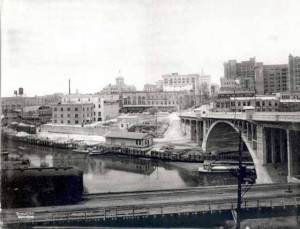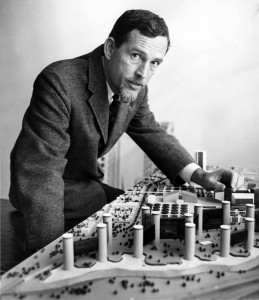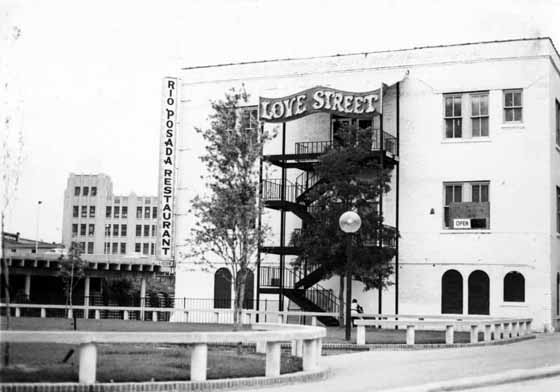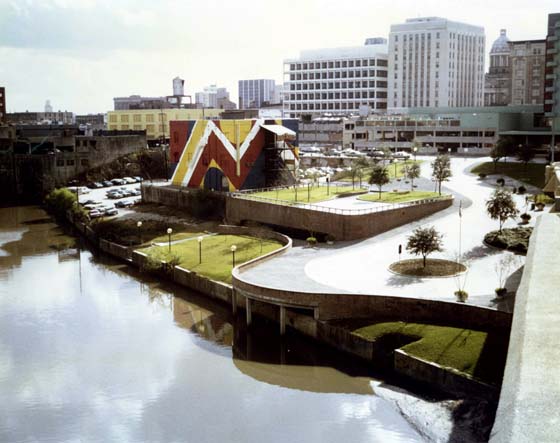
History is where you find it . . . often in bits and pieces . . . a puzzle to be assembled.
At the University of Houston Libraries, Special Collections we have one piece of the historical puzzle known as the Sunset Coffee Building. Only a few yards from Allen’s Landing, where the city was founded, this building has been a fixture downtown since 1910. A century ago its waterfront location permitted access to boats and barges headed to Galveston Bay and beyond. It had many uses over the years until it was abandoned and left to decay. In 2013 Houston First Corporation and the Buffalo Bayou Partnership announced a restoration and adaptive reuse project that would turn the Sunset Coffee Building into a downtown cultural and entertainment destination. (For more information, see “Our Vision: Sunset Coffee Building”.)

Allen’s Landing, early 1900s. Sunset Coffee Building is left of center, in front of white building. Photo by Frank J. Schlueter. Courtesy Houston Public Library
For this puzzle we have a piece at the beginning (1910) and a piece at the end (2013), but what about the pieces in the middle? No doubt there are many, but Special Collections holds a significant one, which can be found in the Burdette Keeland Architectural Papers.
Burdette Keeland (UH 1950) was a prolific designer and an influential member of the UH Architecture faculty. To his students, he was cool. Joe Mashburn, later Dean of the College of Architecture, recalled, “I remember Burdette Keeland, Jr. emerging from his gray MG roadster and walking across that asphalt with his suit jacket over his shoulder and smoking a thin cigar. As students, we thought this was the way it should be for an architect – a cool sports car, a sleek Italian jacket. We wanted to be like him.” (“Burdette Keeland Jr. Remembered,” Cite 48 (Summer 2000), 9).

Burdette Keeland, Jr., late 1960s. Burdette Keeland Architectural Papers, UH Libraries, Special Collections (“Keeland Papers”).
In the late 1960s the cool Mr. Keeland was part of a joint venture that bought what is now known as the Sunset Coffee Building with plans to develop it as an entertainment venue. Keeland acted as architect for the group and provided space for a restaurant and two nightclubs. To reach them, he added a three-story outdoor staircase, and in keeping with the spirit of the times, later painted the building in a wild psychedelic color scheme.

Love Street Light Circus and Feel Good Machine (c. 1967). Keeland Papers.
The top floor became home to the celebrated Love Street Light Circus and Feel Good Machine, run by artist David Adickes. From 1967 to 1970 Love Street hosted many of the top local bands of the day, such as the 13th Floor Elevators, Fever Tree, the Moving Sidewalks, and later, ZZ Top. Go-go dancers joined the bands onstage, while patrons lounged on the floor enjoying refreshments. (For more on Love Street, see “David Adickes – Love Street Light Circus and More” or “LOVE STREET LIGHT CIRCUS
AND FEELGOOD MACHINE!!!”)

Sunset Coffee Building with psychedelic paint scheme (c. 1971). Keeland Papers.
For a few years the building played an important role in Houston’s version of the “Summer of Love,” the heyday of the hippies and the counterculture movement. Popular with its patrons but unsuccessful as a business, Love Street closed in 1970. Keeland and his partners later sold the building. It was a short but colorful chapter in the life of this historic building. At Special Collections we have many such chapters, each waiting for researchers to fit them into their proper places in a larger historical puzzle.